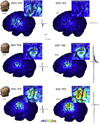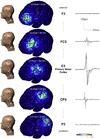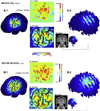Physiological and modeling evidence for focal transcranial electrical brain stimulation in humans: a basis for high-definition tDCS
- PMID: 23370061
- PMCID: PMC4359173
- DOI: 10.1016/j.neuroimage.2013.01.042
Physiological and modeling evidence for focal transcranial electrical brain stimulation in humans: a basis for high-definition tDCS
Abstract
Transcranial Direct Current Stimulation (tDCS) is a non-invasive, low-cost, well-tolerated technique producing lasting modulation of cortical excitability. Behavioral and therapeutic outcomes of tDCS are linked to the targeted brain regions, but there is little evidence that current reaches the brain as intended. We aimed to: (1) validate a computational model for estimating cortical electric fields in human transcranial stimulation, and (2) assess the magnitude and spread of cortical electric field with a novel High-Definition tDCS (HD-tDCS) scalp montage using a 4 × 1-Ring electrode configuration. In three healthy adults, Transcranial Electrical Stimulation (TES) over primary motor cortex (M1) was delivered using the 4 × 1 montage (4 × cathode, surrounding a single central anode; montage radius ~3 cm) with sufficient intensity to elicit a discrete muscle twitch in the hand. The estimated current distribution in M1 was calculated using the individualized MRI-based model, and compared with the observed motor response across subjects. The response magnitude was quantified with stimulation over motor cortex as well as anterior and posterior to motor cortex. In each case the model data were consistent with the motor response across subjects. The estimated cortical electric fields with the 4 × 1 montage were compared (area, magnitude, direction) for TES and tDCS in each subject. We provide direct evidence in humans that TES with a 4 × 1-Ring configuration can activate motor cortex and that current does not substantially spread outside the stimulation area. Computational models predict that both TES and tDCS waveforms using the 4 × 1-Ring configuration generate electric fields in cortex with comparable gross current distribution, and preferentially directed normal (inward) currents. The agreement of modeling and experimental data for both current delivery and focality support the use of the HD-tDCS 4 × 1-Ring montage for cortically targeted neuromodulation.
Copyright © 2013. Published by Elsevier Inc.
Figures





Similar articles
-
Comparing cortical plasticity induced by conventional and high-definition 4 × 1 ring tDCS: a neurophysiological study.Brain Stimul. 2013 Jul;6(4):644-8. doi: 10.1016/j.brs.2012.09.010. Epub 2012 Oct 13. Brain Stimul. 2013. PMID: 23149292
-
Reduced Current Spread by Concentric Electrodes in Transcranial Electrical Stimulation (tES).Brain Stimul. 2016 Jul-Aug;9(4):525-8. doi: 10.1016/j.brs.2016.03.001. Epub 2016 Mar 9. Brain Stimul. 2016. PMID: 27061368
-
A pilot study on effects of 4×1 high-definition tDCS on motor cortex excitability.Annu Int Conf IEEE Eng Med Biol Soc. 2012;2012:735-8. doi: 10.1109/EMBC.2012.6346036. Annu Int Conf IEEE Eng Med Biol Soc. 2012. PMID: 23365997 Free PMC article.
-
Transcranial current stimulation in epilepsy: A systematic review of the fundamental and clinical aspects.Front Neurosci. 2022 Aug 25;16:909421. doi: 10.3389/fnins.2022.909421. eCollection 2022. Front Neurosci. 2022. PMID: 36090277 Free PMC article.
-
Transcranial direct current stimulation in obsessive-compulsive disorder: an update in electric field modeling and investigations for optimal electrode montage.Expert Rev Neurother. 2019 Oct;19(10):1025-1035. doi: 10.1080/14737175.2019.1637257. Epub 2019 Jul 8. Expert Rev Neurother. 2019. PMID: 31244347 Review.
Cited by
-
Beta tACS of varying intensities differentially affect resting-state and movement-related M1-M1 connectivity.Front Neurosci. 2024 Sep 20;18:1425527. doi: 10.3389/fnins.2024.1425527. eCollection 2024. Front Neurosci. 2024. PMID: 39371612 Free PMC article.
-
What Do We Know about Transcranial Direct Current Stimulation for Major Depression?Brain Sci. 2020 Jul 25;10(8):480. doi: 10.3390/brainsci10080480. Brain Sci. 2020. PMID: 32722399 Free PMC article.
-
Exploring prefrontal cortex functions in healthy humans by transcranial electrical stimulation.Neurosci Bull. 2015 Apr;31(2):198-206. doi: 10.1007/s12264-014-1501-9. Epub 2015 Feb 14. Neurosci Bull. 2015. PMID: 25680572 Free PMC article. Review.
-
Investigating the neural mechanisms of transcranial direct current stimulation effects on human cognition: current issues and potential solutions.Front Neurosci. 2024 Jun 18;18:1389651. doi: 10.3389/fnins.2024.1389651. eCollection 2024. Front Neurosci. 2024. PMID: 38957187 Free PMC article. Review.
-
Effect of transcranial direct current stimulation and narrow-band auditory stimulation on the intraoperative electroencephalogram: an exploratoratory feasibility study.Front Psychiatry. 2024 Jul 16;15:1362749. doi: 10.3389/fpsyt.2024.1362749. eCollection 2024. Front Psychiatry. 2024. PMID: 39081532 Free PMC article.
References
-
- Antal A, Nitsche MA, Kincses TZ, Kruse W, Hoffmann K, Paulus W. Facilitation of visuo-motor learning by transcranial direct current stimulation of the motor and extrastriate visual areas in humans. Eur. J. Neurosci. 2004;19:2888–2892. - PubMed
-
- Antal A, Boros K, Poreisz C, Chaieb L, Terney D, Paulus W. Comparatively weak after-effects of transcranial alternating current stimulation (tACS) on cortical excitability in humans. Brain Stimul. 2008;1:97–105. - PubMed
-
- Barker AT, Jalinous R, Freeston IL. Non-invasive magnetic stimulation of human motor cortex. Lancet. 1985;1:1106–1107. - PubMed
-
- Baudewig J, Nitsche MA, Paulus W, Frahm J. Regional modulation of BOLD MRI responses to human sensorimotor activation by transcranial direct current stimulation. Magn. Reson. Med. 2001;45:196–201. - PubMed
-
- Bikson M, Datta A. Guidelines for precise and accurate computational models of tDCS. Brain Stimul. 2012;5:430–431. - PubMed
MeSH terms
Grants and funding
LinkOut - more resources
Full Text Sources
Other Literature Sources
Medical

